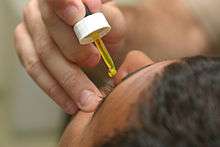Fluorescein (medical use)
Fluorescein is used to help in the diagnosis of a number of eye problems.[1] When applied as a drop or within a strip of paper to the surface of the eye it is used to help detect eye injuries such as foreign bodies and corneal abrasions.[2][3] When given by mouth or injection into a vein it is used to help evaluate the blood vessels in the back of the eye during fluorescein angiography.[1]
 Fluorescein drops being put in the eye before examination | |
| Clinical data | |
|---|---|
| Pronunciation | FLURE-a-seen |
| Routes of administration | topical (eye drops), intravenous, by mouth |
| ATC code | |
| Legal status | |
| Legal status |
|
| Identifiers | |
IUPAC name
| |
| CAS Number | |
| PubChem CID | |
| DrugBank | |
| ChemSpider | |
| UNII | |
| KEGG | |
| ChEBI | |
| ChEMBL | |
| Chemical and physical data | |
| Formula | C20H10Na2O5 |
| 3D model (JSmol) | |
SMILES
| |
InChI
| |
When applied to the surface of the eye side effects may include a brief period of blurry vision and discoloration of contact lenses of the soft type.[4][1] When used by mouth or injection side effects may include headache, nausea, and a change to the color of the skin for a brief period of time.[1] Allergic reactions may rarely occur.[1] Fluorescein is a dye which is taken up by damaged cornea such that the area appears green under cobalt blue light.[1] There is also a version that comes premixed with lidocaine.[2]
Fluorescein was first made in 1871.[5] It is on the World Health Organization's List of Essential Medicines, the most effective and safe medicines needed in a health system.[6] The wholesale cost in the developing world is about US$12.25 per 5 ml bottle.[7] In the United Kingdom a single dose costs the NHS about 0.43 pounds.[2] It is also not very expensive in the United States.[3]
Other animals
It is also sometimes administered to pets in multi-pet environments to determine which pet needs behavioral modification.
References
- Duvall, Brian; Kershner, Robert M. (2006). Ophthalmic Medications and Pharmacology. SLACK Incorporated. p. 29. ISBN 9781556427503. Archived from the original on 2017-01-18.
- British national formulary : BNF 69 (69 ed.). British Medical Association. 2015. pp. 769, 772. ISBN 9780857111562.
- Hamilton, Richart (2015). Tarascon Pocket Pharmacopoeia 2015 Deluxe Lab-Coat Edition. Jones & Bartlett Learning. p. 416. ISBN 9781284057560.
- WHO Model Formulary 2008 (PDF). World Health Organization. 2009. p. 314. ISBN 9789241547659. Archived (PDF) from the original on 13 December 2016. Retrieved 8 January 2017.
- Bartlett, Jimmy D.; Jaanus, Siret D. (2008). Clinical Ocular Pharmacology. Elsevier Health Sciences. p. 283. ISBN 0750675764. Archived from the original on 2017-01-18.
- "WHO Model List of Essential Medicines (19th List)" (PDF). World Health Organization. April 2015. Archived (PDF) from the original on 13 December 2016. Retrieved 8 December 2016.
- "Fluorescein". International Drug Price Indicator Guide. Retrieved 8 December 2016.